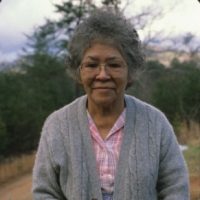
Emma Taylor
Emma Taylor was widely recognized as an especially gifted and productive basket maker in the tradition of the Eastern Band of Cherokee Indians. Born in 1920, Taylor grew up in the Birdtown community of the Qualla Indian Boundary. By the age of seven, she had learned to imitate her mother’s basketry skills by working with discarded oak splints from finished baskets. Later, while attending the Cherokee school, she received more formal training in this ancient art from master basket weaver Lottie Stamper. By the time she was a young woman, Emma could produce sturdy baskets of white oak, honeysuckle, or rivercane. After her marriage to Timpson Taylor, she began making baskets for sale. She continued to do this for income while raising her eight children.
As Taylor matured in her craft, she chose to specialize in white oak basketry. Until her later years, she gathered and prepared all of the raw materials herself. This required locating the trees, cutting them down, splitting the logs into quarters, and preparing the splints for weaving. She also prepared her own dyes from the bloodroot and walnut that she gathered in the forest.
Over the years, Taylor developed an impressive variety of baskets, such as fruit and bread trays, waste baskets, shopping baskets, and flower baskets, in which she combined the qualities of both function and beauty. Her work won numerous awards at craft exhibitions, and she was the only Native American craftsperson invited to demonstrate her basketweaving at the World Craft Council in Kyoto, Japan. She often demonstrated her celebrated basketry technique at local schools, at festivals, and at the Oconaluftee Indian Village in Cherokee. She was also featured in the documentary film Cherokee Basketmakers produced by Qualla Arts and Crafts.
Taylor believed that “basketmaking should be carried on by the younger generations as long as the world stands, because that’s our trade.” She received the North Carolina Heritage Award in 1989.


